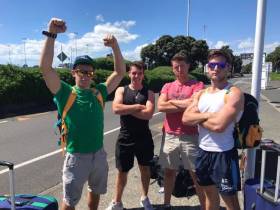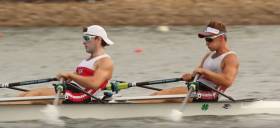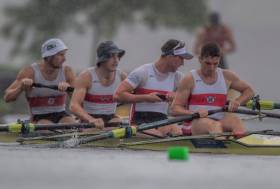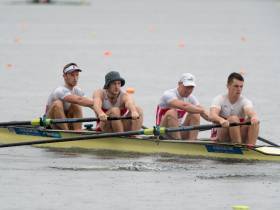Displaying items by tag: Mark O'Donovan
Skibbereen Rowing Regatta Cancelled
#Rowing: Skibbereen Regatta, set for this Saturday and Sunday, April 14th and 15th, at the National Rowing Centre, has been cancelled. The weather forecast, which orginally put the Sunday of the event in doubt, worsened. Saturday evening was set to feature a south east wind which would have made parts of the course unrowable. The organisers decided to abandon both days. The event featured a record entry for a domestic regatta.
Skibbereen Sunday in Doubt on Bumper Weekend for Irish Rowers
#Rowing: This weekend is one of the busiest of the year for Irish rowers. At the National Rowing Centre in Cork the University Championships of Ireland will be held on Friday, April 13th, and Skibbereen Grand League Regatta is scheduled for Saturday and Sunday, April 14th and 15th. This event has its biggest-ever entry, but a very bad weather forecast for the Sunday has put competition on that day in doubt. Three Ireland women’s crews will also compete in an international regatta in Italy, the Memorial Paolo d’Aloja in Piediluco.
World champions Mark O’Donovan and Shane O’Driscoll and Olympic medallists Paul O’Donovan and Gary O’Donovan arrived home earlier this week after three months training and competition in New Zealand and Australia. The four Skibbereen men intend to compete in their home club’s regatta.
On Friday, over 140 crews from 10 different universities and colleges around the country will compete in the University Championships. The event is set to start at 9:30 am with a straight final of the senior men’s fours and races will run throughout the day. The final contest, the men’s senior eights is scheduled for 4:20 pm.
In Italy, two-time Olympian Sanita Puspure will compete in the heavyweight women’s single sculls in Piediluco. Aileen Crowley and Monika Dukarska will race in a double scull, while Emily Hegarty and Aifric Keogh are set to compete in a pair.
O'Driscoll and O'Donovan Inches Away in Sydney Four
#Rowing: Mark O’Donovan and Shane O’Driscoll finished just 15 hundredths of a second off a medal placing in the men’s four at the Sydney International Rowing Regatta. The Skibbereen men teamed up with Australian internationals Ben Coombs and Tim Masters to form the crew which just missed out in the five-boat race.
Patrick Boomer, who represented Ireland at the World Championships in 2017, was part of the winning crew.
Sydney International Rowing Regatta, Day Five (Friday; Irish interest)
Men
Open Four – Final: 1 Melbourne Univ/Mercantile-NTC (P Boomer, S Keenan, J Dunkley-Smith, J Booth) 6:04.8; 4 Skibbereen-NTC (T Masters, B Coombs, M O’Donovan, S O’Driscoll) 6:12.78
Open Double Sculls – A Final: 1 Adelaide/Sydney (A Hill, D Watts) 6:26.08, 2 UTS/Sydney 6:28.34, 3 Sydney University-NTC 6:30.45; 5 Skibbereen (G O’Donovan, P O’Donovan) 6:33.28.
O'Driscoll and O'Donovan Win B Final at Sydney Regatta
#Rowing: Shane O’Driscoll and Mark O’Donovan won the B Final of the men’s Open Pair at the Sydney International Rowing Regatta. The Skibbereen men led through the 500 metre mark and halfway and eventually won by over five seconds at Penrith. They finished ninth overall.
Paul O'Donovan Takes A Final Place at Sydney Rowing Regatta
#Rowing: Paul O’Donovan has qualified for the A Final of the men’s Open single sculls at the Sydney International Rowing Regatta in Australia. The Skibbereen man finished second in his semi-final. The Skibbereen pair of Mark O’Donovan and Shane O’Driscoll are set for a B Final in the Open category as they missed out on qualifying through their repechage.
Fast Win in Sydney Heat for O'Donovan Brothers
#Rowing: Paul O’Donovan and Gary O’Donovan won their heat of the Open double sculls at the Sydney International Rowing Regatta in Australia. The Skibbereen duo had the fastest time of the two heats. They will compete in the A Final on Friday. The brothers are featured in the video below, scroll to 26 seconds in the timeline.
Mark O’ Donovan and Shane O’Driscoll took sixth place in their heat of the Open pair. They must compete in a repechage in an attempt to qualify for the A Final.
Sydney International Rowing Regatta, Day Two (Tuesday; Irish interest)
Men
Open Pair – Heat One (First two crews to A Final; rest to Repechages): 6 Skibbereen (M O’Donovan, S O’Driscoll) 7:03.94.
Open Double Sculls – Heat Two (First two crews to A Final; rest to Repechages): 1 Skibbereen (G O’Donovan, P O’Donovan) 6:24.19.
Irish Quartet Rate Highly in Australia
#Rowing: Australian rowing has given a warm welcome to the Irish quartet of Paul O’Donovan and Gary O’Donovan and Shane O’Driscoll and Mark O’Donovan. Rowing Australia says the Irish, who returned from the 2017 World Championships with two gold medals, are “headlining the international line-up” at the Sydney International Regatta next week. The four have been enjoying the sights and climbs of Sydney.
Skibbereen Four Take Premier Medal at New Zealand Championships
#Rowing: An Irish crew have taken a medal in the Premier grade at the New Zealand Rowing Championships. The Skibberen four of Gary O’Donovan, Paul O’Donovan, Mark O’Donovan and Shane O’Driscoll finished third in the Premier four, just a second ahead of fourth.
New Zealand Rowing Championships, Lake Karapiro, Day Five (Irish interest)
Men
Four – Premier
A Final: 3 Skibbereen (G O’Donovan, P O’Donovan, M O’Donovan, S O’Driscoll) 5:58.82.
Paul O'Donovan and Skibbereen Four Win Place in New Zealand Finals
#Rowing: Paul O’Donovan, in the Premier (open weight) single sculls, and the Skibbereen four both made it to A Finals at the New Zealand Rowing Championships. O’Donovan won in a repechage to join some of the top heavyweight single scullers in the world in the final. Gary O’Donovan took third in the race and will compete in the B Final.
The two brothers joined Mark O’Donovan and Shane O’Driscoll to form a four which won its repechage and will also compete in a final with top heavyweight crews.
Mark O’Donovan and Shane O’Driscoll took fifth in their repechage of the Premier Pair and missed out on the final, while Max Murphy made it through to the A Final of the men’s pair and NUIG’s Kevin Neville and Eamon Power progressed through repechages in the senior single and club single respectively.
New Zealand Rowing Championships, Lake Karapiro, Day Two (Irish interest)
Men
Four – Premier
Repechage Two (First two to A Final; rest to B Final): 1 Skibbereen (G O’Donovan, P O’Donovan, M O’Donovan, S O’Driscoll) 6:21.39.
Pair – Premier
Repechage (Top Four to Final; rest eliminated): 5 Skibbereen (S O’Driscoll, M O’Donovan) 7:11.47.
Senior
Repechage (Top Three to Final): 2 Waikato (M Murphy, T Bedford) 7:33.13.
Sculling,
Single – Premier
Repechage One (First two to Final; rest to B Final): 1 Skibbereen (P O’Donovan) 7:23.32; 3 Skibbereen (G O’Donovan) 7:55.63.
Senior
Repechage Three (First Two to Semi-Final): 2 Wairau (K Neville) 7:29.91.
Club
Repechage One (First Two to Semi-Final): 1 Wairau (E Power) 8:19.07.
Ireland Pair in Tight Finish in New Zealand
#Rowing: Mark O’Donovan and Shane O’Driscoll were eliminated from the Premier Pair at the New Zealand Rowing Championships on Wednesday (local time). The world lightweight pairs champions knew they would have some tough races as they learnt their trade in the heavyweight ranks, and this was one. In a tight repechage, rowed into a headwind, the Skibbereen men lost out by 1.64 seconds a three-way battle for the crucial third and fourth places which guaranteed a slot in the final.
Max Murphy secured a place in the final of the men’s senior pair, as his Waikato crew finished second in a repechage, while Eamon Power won his repechage of the club single sculls to secure a place in the semi-finals.
New Zealand Rowing Championships, Lake Karapiro, Day One (Irish interest; selected results)
Men
Pair – Premier - Repechage (Top Four to Final; rest eliminated): 5 Skibbereen (S O’Driscoll, M O’Donovan) 7:11.47.
Senior - Repechage (Top Three to Final): 2 Waikato (M Murphy, T Bedford) 7:33.13.
Sculling, Single – Club – Repechage One (First Two to Semi-Final): 1 Wairau (E Power) 8:19.07.




































































